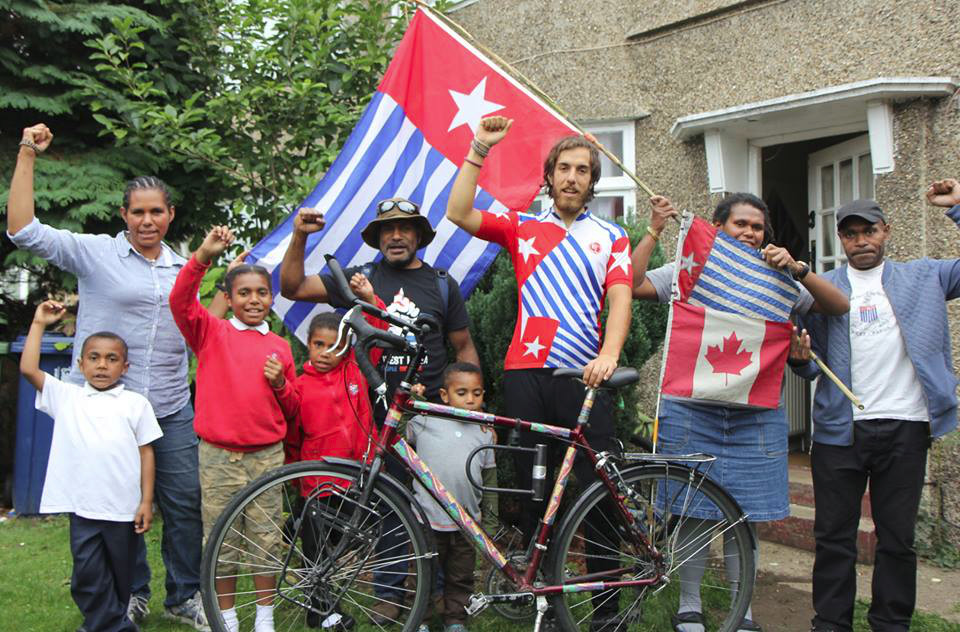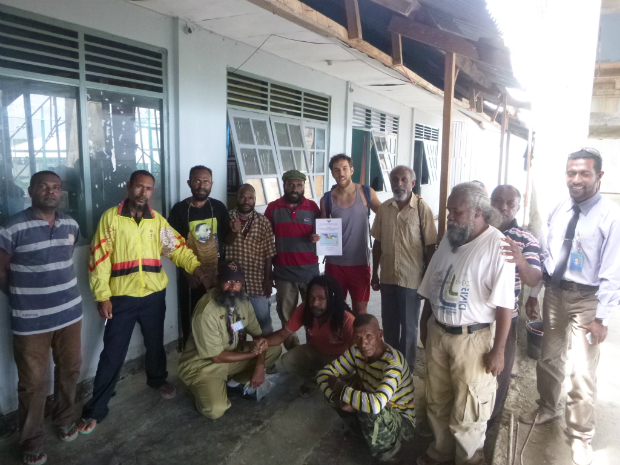It’s been over a month since I rode my bicycle into Melbourne, closing out the final 20km of the 12,000km Pedalling for Papua tour. It’s been almost a month since that tour led me back to West Papua, and into one of the region’s most notorious prisons.
In 2012, I rode my bicycle 7,500 kilometers across Canada, delivering a multimedia presentation based on five weeks of travel and research I’d done in West Papua the previous year. That was the first Pedalling for Papua campaign, designed to transform the story of West Papua into a Canadian household topic.
The second campaign began on 23 May 2013, with the first of what ended up being 70 awareness raising events over six months and through seven countries. This campaign has been at the centre of my life for nearly three years. I’ve been irresistibly drawn by the beautiful, horrible and, ultimately, unfinished story of West Papua. It is a story that is all too familiar in our colonial world.

The First Nations People of Canada, my home country, have lived through a recent handful of dark generations. Their lands were stolen and redistributed, their sacred way of life was disregarded as primitive, and their children were stolen from them, placed in government-supported and church-run residential schools. These institutions stated cultural genocide as an explicit purpose, sterilised students, and left generation after generation with a legacy of physical and sexual abuse.
I write "a handful of generations" because it is, of course, only the most recent history of First Nations people here that have been made to participate in this tragic story. The resiliency of a culture and people built on hundreds of sustainable generations has never left this land we renamed Canada, and has recently articulated itself in the now global Idle No More movement, which, while I was pedalling through Australia, I was grateful to learn had reached there as well.
It is a story that repeats itself around the world, and when I first heard about what was happening in West Papua, all I remember thinking is that this is, once again, the same damn thing.
It wasn’t until 1969 that West Papua was officially annexed by Indonesia, in a UN supervised referendum that educated circles typically refer to as the "Act of No Choice". After Indonesia won its independence from the Dutch, West Papua, then known as Netherlands New Guinea, was kept out of their reach. The Dutch planned to prepare the region for independence.
This reality hung tantalisingly close on 1 December 1961, when the new national anthem, Hai TanahKu Papua (Oh My Land Papua) was first sung, and the freshly sewn Morning Star Flag was first raised. Indonesia, however, acted quickly, entering West Papua with their military in early 1962.
The eventual compromise, laid down in the New York Agreement, was that Indonesia would gain temporary administrative control of the region on the condition that West Papuans, before the end of the decade, would be allowed an "Act of Free Choice" in order to decide whether to remain with Indonesia, or become a new nation. There was no technical precedent for this process, and it could be easily manipulated. The Act of Free Choice was, predictably, a sham, as 1,025 West Papuans were hand picked and told to vote at gunpoint in favour of Indonesia. They unanimously consented.
Since that time, a dynamic struggle for independence and equity has been fought by West Papuans, who have increasingly felt the effects of becoming a minority in their own land. Economic opportunity is fraught with discrimination as more and more Indonesian transmigrants land on their shore. And even today, those speaking up against the government and for independence risk imprisonment, torture and death. In many schools, West Papuan children are not allowed to speak their native tongue.
The parallels between this indigenous struggle, only two generations old, to those in Canada, Australia, and all over the world, were just too striking. I have spent the last two years telling this story. The multimedia presentation I carried with me this past year brought the recorded voices of West Papuan refugees on stage via their projected, animated avatars.

After that final ride into Melbourne on 1 December 2013, 52 years after the first hopeful flag raising, I was grateful to be received by the song, dance and ceremony of the local community of West Papuan refugees. The following days were spent delivering presentations and interviews with media, while preparing as well as I could to bring these past few years of experience back to West Papua with me, as I’d been planning with a circle of confidantes to do for perhaps the last month of the campaign.
I’d been collecting postcards and videos bearing messages of support for the political prisoners I’d been advocating for throughout the campaign (with the help of www.papuansbehindbars.org), with the eventual plan to hop on a plane back to West Papua, bring the messages to Abepura Prison, where so many of these men are held, and get hastily arrested and deported back to Canada.
This, however, never happened, a success which I chalk up to the brilliant coordination between my team in West Papua, one of the better connected political prisoners, and some Papua prison guards with mixed loyalties. After the action, however, some Indonesian media decided that the success of the mission meant something very different. I experienced, for the first time ever, being misquoted in media.
It was bizarre and insulting to have robotic words like, “I was happy I could deliver the post cards. It turned out that Papua is not like what I have heard,” put into my mouth. The effective and honest reporting that came out of the action, however, softened the blow considerably. Now that I’m back home in Canada, able to safely reflect on how it all went down, I’m feeling pretty grateful.
I remember sitting down to dinner in Canberra in mid-November, with a small community of West Papuans I’d met at a rally for refugees the day before. The matriarch of the group, a beautiful older woman who’d been living away from home for over 20 years, did me the incredibly honor of calling me ambassador, and I’ve been granted that title a few times since.
I’m not sure what the future holds for West Papua, or what my part in the story is ultimately meant to be. What I do know is that I’ve been changed by the place, and that anyone who chances upon either this or any of the hundreds of compelling resources available online, will be as well. West Papua is worth knowing about. West Papua is worth pedalling for.
Donate To New Matilda
New Matilda is a small, independent media outlet. We survive through reader contributions, and never losing a lawsuit. If you got something from this article, giving something back helps us to continue speaking truth to power. Every little bit counts.



